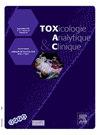Bladder wash as an alternative specimen for post-mortem toxicology: Feedback from 63 authentic samples
IF 1.7
Q4 TOXICOLOGY
引用次数: 0
Abstract
Aim
In post-mortem toxicology, analysis of different biological matrices is crucial to confirm what has been identified in blood. Nevertheless, conventional matrices can be difficult to analyze with standard extraction protocol or missing. The concept of bladder washing has been introduced in 2022 at the TIAFT annual meeting [1]. The evaluation was carried out after emptying bladder and then rewashing it. But real-life conditions can be difficult with putrefied, polytraumatized or carbonized corpses. The first bladder wash was performed in Grenoble in November 2022 by forensic pathologist team and is now performed routinely. The authors aim to describe bladder wash sampling technique and present a critical evaluation in current post-mortem toxicology practice.
Method
Bladder wash was achieved when bladder was empty, with a 5 mL wash of 0.9% NaCl solution during the forensic autopsy.
This study included authentic bladder washes from November 2022 to November 2024. Toxicological analysis were performed on request of police officers or prosecutors. The analysis was carried out in LC-MS/MS, LC-HRMS for screenings of drugs of abuses and medications and GC-FID for volatiles.
Sample preparation for screening consisted in a phospholipid removal using Ostro® plates. Targeted LC-MS/MS screenings were carried out on an Acquity UPLC HSS C18 column (2.1 × 100 mm) and a Xevo TQ-XS mass spectrometer (Waters). Targeted LC-HRMS screenings were carried out on an Accucore Phenyl-Hexyl column (2.1 × 100 mm) and an Exploris 120 (Thermo Scientific) mass spectrometer.
To evaluate the efficiency of the wash, creatininuria and proteinuria assays were carried out on an Atellica system (Siemens Healthineers®) using automated enzymatic and colorimetric techniques.
Results
This study included 63 authentic bladder washes. Mean bladder wash volume was 2,3 mL. Subjects were aged from 1 month to 92 years with mean body mass index of 26.6. Mean post-mortem interval was 2.5 days.
No substance was identified in 8 washes. Among the substances identified, psychotropic drugs (lithium, cyamemaine, venlafaxine, diazepam, vortioxetine, valproic acid, pregabaline…), drugs of abuse (cocaine, MDMA, THC-COOH, oxycodone, methadone, morphine…), cardiotropic and antidiabetic medications (amlodipine, sotalol, irbesartan, amiodarone, ramiprilat, metformine, sitagliptine, gliclazide…), anesthesic drugs (sufentanil, midazolam, laudanosine, etomidate, propofol, ketamine) or metabolites (ethylglucuronide, cotinine, acetone) were correctly detected in bladder wash.
Between blood and bladder wash results, a concordance of 76.2% was observed in this study, including ethanol. In 15.9% cases, bladder wash was negative and only ethanol was identified in blood. Therefore, ethanol is difficult to detect in bladder washes, due to the dilution. Regarding other xenobiotics, blood was positive for acetaminophen, urapidil, THC-COOH, pantoprazole, and were not detected in bladder washes in several cases.
Regarding biochemical analysis, 86.2% of the washes had undetectable levels of creatinine (inferior to 0.18 mmol/L) and elevated proteinuria (mean 4.32 g/L).
Conclusion
The feedback from 63 authentic bladder washes compared to blood in forensic routine analysis over 2 years is satisfying. It is possible to identify a large panel of substances with standard procedure.
Bladder wash may not require highly sensitive technique regarding our simple sample preparation protocol. Given the sensitivity of recent mass spectrometers, bladder wash is more convenient to analyze that bile or gastric content. Indeed, less matrix effect was observed than bile on our MS/MS and HRMS screening techniques.
Bladder wash may not be resuspended urine regarding biochemical analysis but a mix of urine and necrotizing urothelium. Further analysis may be required to properly characterize this new matrix.
Bladder wash provided satisfactory results as biological matrix for blood confirmation purposes in routine activity. This study highlights the benefits of collaboration with forensic pathologist in the evolution of practices.
膀胱冲洗液作为尸检毒理学的替代样本:63 份真实样本的反馈意见
在死后毒理学中,对不同生物基质的分析对于确认血液中已确定的物质至关重要。然而,传统的矩阵可能难以分析与标准提取协议或缺失。在2022年的TIAFT年会上,膀胱清洗的概念被引入。在排空膀胱并重新冲洗后进行评估。但在现实生活中,腐烂、多处创伤或碳化的尸体可能会很困难。法医病理学家团队于2022年11月在格勒诺布尔进行了第一次膀胱清洗,现在已成为常规操作。作者的目的是描述膀胱冲洗取样技术和目前的尸检毒理学实践的关键评估。方法在法医解剖时,在膀胱空的情况下,用5 mL 0.9% NaCl溶液冲洗膀胱。这项研究包括从2022年11月到2024年11月的真实膀胱洗涤。毒理学分析是应警察或检察官的要求进行的。采用LC-MS/MS、LC-HRMS对滥用药物和药物进行筛选,GC-FID对挥发物进行分析。用于筛选的样品制备包括使用Ostro®板去除磷脂。采用Acquity UPLC HSS C18色谱柱(2.1 × 100 mm)和Xevo TQ-XS质谱仪(Waters)进行靶向LC-MS/MS筛选。采用Accucore Phenyl-Hexyl色谱柱(2.1 × 100 mm)和Exploris 120 (Thermo Scientific)质谱仪进行靶向LC-HRMS筛选。为了评估洗涤的效率,在Atellica系统(Siemens Healthineers®)上使用自动酶和比色技术进行肌酐尿和蛋白尿测定。结果本研究包括63例真实膀胱洗涤。平均膀胱冲洗量为2.3 mL。受试者年龄1个月至92岁,平均体重指数26.6。平均死亡间隔为2.5天。8次洗涤均未发现任何物质。在鉴定的物质中,精神药物(锂、氰胺、文拉法辛、地西泮、伏替西汀、丙戊酸、普瑞巴林……)、滥用药物(可卡因、MDMA、四氢大麻酚、羟考酮、美沙酮、吗啡……)、促心药物和抗糖尿病药物(氨氯地平、索他洛尔、厄贝沙坦、胺碘酮、雷米普利拉特、二甲双胍、西格列汀、格列齐特……)、麻醉药物(舒芬太尼、咪达唑仑、劳达诺辛、依托咪酯、异丙酚、氯胺酮……)或代谢物(乙基葡萄糖酸苷、可替宁、膀胱洗涤中丙酮的检出正确。在本研究中,包括乙醇在内,血液和膀胱清洗结果的一致性为76.2%。15.9%的患者膀胱冲洗阴性,血液中仅检出乙醇。因此,由于稀释,在膀胱洗涤中很难检测到乙醇。对于其他外源药物,血液中对乙酰氨基酚、乌拉地尔、四氢大麻酚、泮托拉唑呈阳性,有几例膀胱冲洗未检出。在生化分析方面,86.2%的洗涤液肌酐水平未检测到(低于0.18 mmol/L),蛋白尿升高(平均4.32 g/L)。结论2年多来,63例真实膀胱冲洗与血液法医学常规分析的反馈令人满意。用标准程序可以识别大量的物质。根据我们简单的样品制备方案,膀胱清洗可能不需要高度敏感的技术。考虑到最近质谱仪的灵敏度,洗膀胱比分析胆汁或胃内容物更方便。事实上,在我们的质谱/质谱和HRMS筛选技术中,基质效应比胆汁效应更少。在生化分析中,膀胱冲洗可能不是重悬尿液,而是尿液和坏死性尿路上皮的混合物。可能需要进一步的分析来正确地描述这个新矩阵。在日常活动中,膀胱冲洗作为血液确认目的的生物基质提供了满意的结果。这项研究强调了在实践的演变中与法医病理学家合作的好处。
本文章由计算机程序翻译,如有差异,请以英文原文为准。
求助全文
约1分钟内获得全文
求助全文

 求助内容:
求助内容: 应助结果提醒方式:
应助结果提醒方式:


